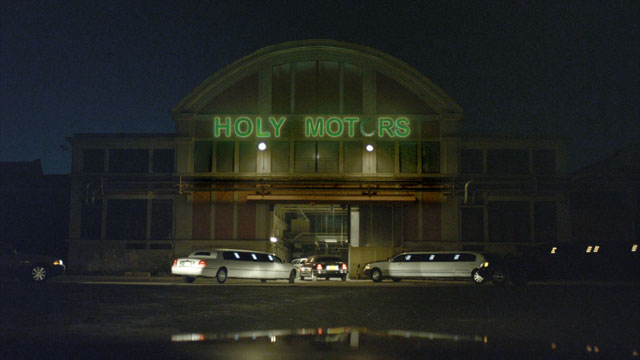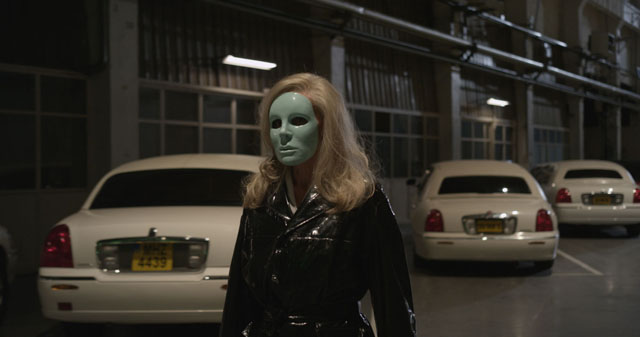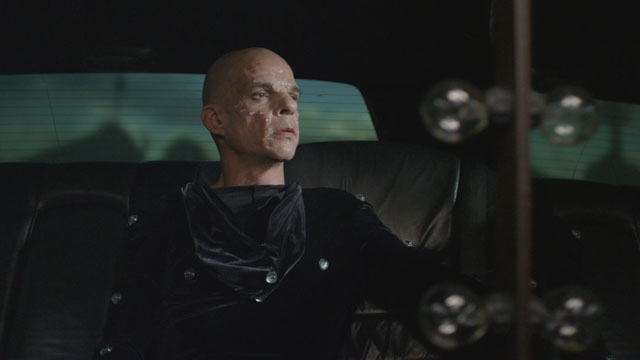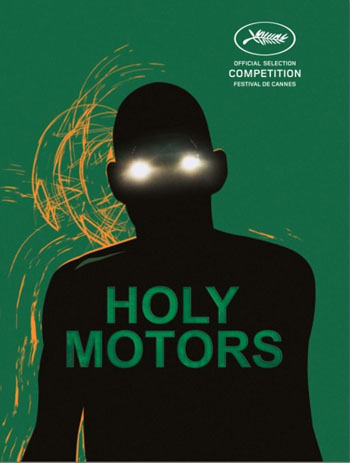“Absent from feature-making since 1999’s Pola X, French cinema’s mystery man Leos Carax makes up for lost time with the rambling, radically loopy Holy Motors,” begins Jonathan Romney in Screen. “A metaphysical fugue in which a protean protagonist shape-shifts through shades of the human condition, Holy Motors will be acclaimed by some as a visionary, game-changing masterpiece and dismissed by others as an derivative wallow in unfocused imagery.”
“Those who’ll complain—and there are apt to be plenty—that Holy Motors is simply preposterous would do well to recall that absurdity is the very definition of surrealism, and that Carax’s first feature in the 13 years since Pola X is nothing if not a surrealist film,” argues Rob Nelson in Variety. “Suffice to say that both animals and machines appear highly intelligent in this neo-futuristic pic; that the notion of human playacting takes on heretofore uncharted dimensions; and that only dream logic—give or take pure cinema—can begin to explain the wacky beauty of what goes on here.”
“With a cast list which includes Michel Piccoli, Eva Mendes and Kylie Minogue, this had over-reaching folly written all over it,” writes David Jenkins at Little White Lies. “However, a rejuvenated Carax has delivered an astonishingly risky and formally audacious work which manages to condense all cinema and all humanity into its brisk 115 minutes. It plays a little but like a Charlie Kaufman film that’s been co-directed by Buñuel and Godard, but even that description doesn’t quite capture the essence of a film which, on first viewing, feels like something entirely new. Hell, let’s just call it the first fictional adaptation of Histoire(s) du Cinema. Diminutive Carax alter ego, Denis Lavant, who started in the director’s infamous early works like Les amants du Pont Neuf (1991) and The Night Is Young (1986), plays Monsieur Oscar.”
The Guardian‘s Peter Bradshaw, who finds the film to be “weird and wonderful, rich and strange—barking mad, in fact,” picks it up from there: Monsieur Oscar is “a strange figure who is chauffeured around in a white stretch limo by Celine (Edith Scob); he has a fully equipped theatrical dressing room in the back of the car, and prepares for a series of ‘appointments’ by getting into various elaborate and deeply preposterous disguises, checking his briefing documents and pulling the latex over his face like a metaphysical Jim Phelps in TV’s Mission Impossible. He is an old woman, a wealthy businessman, a tramp, an assassin. At one stage he is a monstrous creature in a turquoise suit who intrudes on a high-fashion photo shoot, and kidnaps the glamorous model, played by Eva Mendes. At another moment, he plays a harassed, grumpy dad, picking up his teenage daughter from a party, and angry and upset that she lies to him about how unhappy she is. At yet another moment, he is an ancient old man on his deathbed, exchanging final confidences with his beautiful, tearful great-niece. In each case, there is utter commitment to this truth, this situation, which will capriciously turn into something else.”
The “monstrous creature in a turquoise suit” is, of course, as indieWIRE‘s Eric Kohn reminds us, Merde, “the elfin vagrant Lavant hilariously portrayed in the segment Carax directed for the omnibus film Tokyo!… Leos Carax has always been a bit nutty, but here he finally flies off the rails with supremely perplexing, occasionally miraculous, always memorable results. This is a movie about movies, life, death, the human condition, monkeys, music, chaos, suicide, whatever. It’s something else…. Carax’s masterful Lovers on the Bridge channeled swooning romanticism into a loony scenario involving emotionally deranged subjects, and Pola X brought an elevated shock value to literary conceits, but Holy Motors defies any such attempt at categorization except perhaps to say that it’s the filmmaker’s 2001: A Space Odyssey, but we’re in his space: an epically cryptic testament to the power of the moving images.”
“Exhilarating, opaque, heartbreaking and completely bonkers,” declares Megan Lehmann in the Hollywood Reporter. “Weird, yes,” grants Guy Lodge in Time Out London. “But even at its most wilfully absurd (let’s just say chimpanzees are involved), there’s something fragile, tender and even truthful about Carax’s hall-of-mirrors irrationality, the sense of an artist so weary of decayed human realities that he has no choice but to twist them into the more beautiful shapes afforded by cinema. By the time the film ends with Scob subtly referencing the character she played 52 years ago in Eyes Without a Face, you might feel an involuntary shiver down the spine—it’s hard to say what forces are propelling this ecstatic, idiotic, fizzy, frightening provocation, but we’re moved by them too.”
Updates: For Mike D’Angelo, writing at the AV Club, Holy Motors is “a work so sui generis, so vast in scope, and so meticulously realized that you can easily imagine Carax having spent every waking hour of the past 13 years working on it—and many non-waking hours to boot, given its dreamlike, surrealistic modus operandi. Ultimately, Holy Motors may prove too bugfuck to win the Palme d’Or, given that the jury is headed by Nanni Moretti and not Tim Burton (whose crew Palme’d the nearly-as-bizarre Uncle Boonmee Who Can Recall His Past Lives), but I can almost guarantee that it’ll be the film by which this year’s festival will be remembered in years to come. Cannes exists to showcase such unexpected cliff-dives.”
Fabien Lemercier at Cineuropa: “From its dizzying heights to its delirious depths, from the sublime to the abject, from the profound to the ostentatious, from humour to pontification, Holy Motors, through its infinite game of mirrors about life and the desire to endlessly relive it, reflects its director who here perpetuates his persona of a damned artist and make his stupendous transformist actor say: ‘I am carrying on as I started: for the sake of art!'”
The Film Society of Lincoln Center’s Eugene Hernandez reports on the press conference.
Updates, 5/24: “Is Carax’s opus a series of short films with a connective conceit?” asks Blake Williams at Ioncinema. “A rumination on digital-age avatars and humanity’s loss of identity, self, and body? Or maybe it’s an apocalyptic fever dream that imagines—cinematically—the meeting of all movie and theatre genres in a single place. Whatever it is and wherever it came from, how lucky we are that a movie like this can still rear its head and remind us of what the medium can do above all other artistic media.”
“Like Alain Resnais’s You Ain’t Seen Nothing Yet, Holy Motors explores the way performance can transcend death, evoking a collective joy in direct contrast with the consistent physical ugliness on display,” writes Glenn Heath Jr. at Press Play. “The film’s most rousing sequence is also its most random: Oscar leads a marching band of accordion players around a closed-off room, the camera tracking backward constantly, so it looks as if the camera is pursued by the musicians. If this sequence resonates with inspiration and joy, the musical number later in the film (with another time-traveling performer played by Kylie Minogue) is fraught with tragedy. As Oscar trails slowly behind, the woman walks through a gutted-out hotel, stepping over pieces of dismembered mannequins littering the floor. Carax’s creation of dualities is endlessly fascinating.”
Blogging for Sight & Sound, Demetrios Matheou makes another Resnais connection: “A prologue features Carax himself navigating a surrealist dreamscape, at the end of which he looks down upon an auditorium, in which an audience sits impassively as Etienne-Jules Marey‘s chronophotographed athletes flicker across a screen. The nod to that early pioneer signals the fact that cinema itself is a subject of the film. At the same time these still figures remind one of Last Year in Marienbad; and like the characters in that film, the protagonist of Holy Motors will be on an endless round of role-playing, in search of an identity.”
“Carax manages to provide a measure of thematic unity to the film that envelops all its wacky ideas and becomes so much more than just a sum of its parts,” finds Michal Oleszczyk at Hammer to Nail.
“I can’t recall a film ever being received so rapturously at Cannes,” writes Melissa Anderson in a dispatch to Artforum, noting that the reception was “a display of gratitude for being so thoroughly transported by such an intensely personal, formally virtuosic work.”
Updates, 5/26: “The premise is paranoid,” writes Daniel Kasman in MUBI’s Notebook, “and suggested by a cameo by Michel Piccoli—not just an Alps-like use of performance as therapy or a necessary part of the social tapestry, but also that all of Levant’s impersonations are being filmed by invisible microscopic cameras for someone’s enjoyment, digital cinema ubiquitous, life, genre and performance blending imperceptibly.” Yet “the conceptual richness of Carax’s free-wheeling oddity is tamed by a calm, undramatic mise-en-scène.”
“Shifting gears at a moment’s notice, Carax’s film repeatedly runs the risk of going off the rails altogether,” writes Budd Wilkins at the House Next Door. “And while it’s refreshing to witness such derring-do in the midst of a festival whose films often seem content to bask in their own self-important humorlessness, that’s still pretty cold comfort when it comes to actually sitting through this misshapen mess, as stultifying as it is surreal, heavy-handed as it can be hilarious.”
Holy Motors “purrs along the dark, deserted highways of the mind with a muscular, erotic charge that is all its own,” writes Robbie Collin in the Telegraph.
Dennis Lim talks with Lavant for the New York Times.
Updates, 5/27: Indomina Releasing has picked up US rights; Alex Billington has more at FirstShowing.
“Holy Motors peaks early,” finds Time Out Chicago‘s Ben Kenigsberg. “Less visually lush than Carax’s other films, Holy Motors sometimes gives off a weird-for-weird’s-sake vibe, but no movie at the festival matched it for scene-for-scene inventiveness.”
Cannes 2012 Index: a guide to the coverage of the coverage. For news and tips throughout the day every day, follow @KeyframeDaily on Twitter and/or the RSS feed. Get Keyframe Daily in your inbox by signing in at fandor.com/daily.







